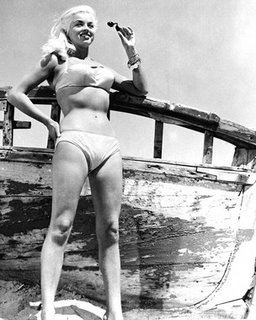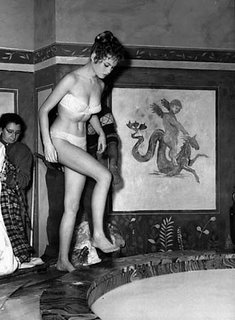

So what was all the fuss about four little triangles of cloth, totaling up to about as much fabric as it takes to make a saree blouse?
Well, believe it or not, in Hollywood, it was about the matter of exposing the navel, an act that apparently amounted to such a severe form of indecent exposure that it was banned from Hollywood films! Okay, let me begin at the beginning, which as Mary Poppins so perspicaciously pointed out, is a very good place to start. By the time World War II had started in 1936, two-piece bathing suits had already made their appearance on and off screen and by the early '40s, many of the famous Hollywood beauties including Ava Gardner, Rita Hayworth, and Lana Turner had all appeared in films wearing them. By the time the war had ended, the lusciously aquatic Esther Williams had made her tryst with stardom in the 1944 Technicolor spectacular, “Bathing Beauty” and as America’s Mermaid, the two-piece bathing suit would become almost second skin for her.
You’d think that in such a scenario, the world was ripe and ready for what made its debut on July 5 1946 at a poolside show at the then famous Paris swimming pool, the Piscine Molitor. Four little (or shall we say itsy-bitsy?) triangles of cloth totaling to 30 inches held together by teeny-weeny bits of string. Its “official” inventor, Lousie Reard, estimated its impact would be not less explosive than the atomic weapons that the United States had just tested in the Bikini Atoll Islands just 4 days earlier. Which is why he christened it le bikini. And since he could not find a model to wear it, he had to get Micheline Bernadini, a nude dancer from a Paris casino to model it. Which was kind of odd because apparently French women had already been wearing the bikini for a year – only it was known only by the more modest “French bathing suits” – a fact photographically recorded by the Life magazine in its July 16th, 1945 issue. (Micheline’s little modeling assignment apparently got her 50,000 letters. According to one report they were fan mail; according to another, they were proposals of marriage!)
Odder still was the reaction in United States of America. Which was mostly priggish scorn. Esther Williams declared, "A bikini is a thoughtless act". In a Time interview in 1950, American swimsuit mogul Fred Cole said he had "little but scorn for France's famed Bikini bathing suits". According to him, the bikini was only to take care of the French girls’ short legs because of which the “swimsuits have to be hiked up at the sides to make their legs look longer." The assumption being that since the American girls were naturally longer-stemmed, they would have no use for such silly artifice. In 1951, the Vogue magazine primly proclaimed, "Our readers dislike the bikini, which has transformed certain coastlines into the backstage of music halls and which does not embellish women." Of course, this was before that flamboyant high priestess of fashion Diana Vreeland became its editor, because she, true to form is reported to have said that the bikini is the atom bomb of fashion, justifying Reard’s choice of name.
But the oddest of all was the reaction of Hollywood. At the time, a peculiar form of film censorship called the Hays Code governed Hollywood films and according to it, the bikini was a no-no on screen. Why, you might well ask. Too much thigh? Nope. Too much bosom? In the land of the Janes Russell and Mansfield? Nah. Could it be that the derrière, till now demurely under covers was daring to show? Nope. Then what, you ask exasperatedly? Well, apparently what the censors found objectionable was that the bikini exposed ….hold your breath, people…the navel!
Naturally, it took an impossibly gorgeous French beauty to impress the advantages of this French invention on America. And so, though the 1957 issue of Modern Girl prissily pronounced, "It is hardly necessary to waste words over the so-called bikini since it is inconceivable that any girl with tact and decency would ever wear such a thing", when Roger Vadim’s film, And God Created Woman was released that year and Brigitte Bardot made the bikini’s unforgettable screen debut in a demurely titillating gingham version, it was all over but for the shouting. America – and most of the western world – capitulated in fervent, feverish adoration, begging for more. And Hollywood was more than willing to oblige and how.
In 1962, when Ursula Andress emerged from the sea in a white bikini like a modern day Venus in the Bond film, Dr. No, it became one of Hollywood’s most incandescent moments and made “Honey Ryder”, the sexiest Bond girl ever. (A position maintained 41 years later when in a survey by UK’s Channel 4, this scene in Dr. No was voted No.1 of cinema’s 100 Greatest Sexy Moments! Incidentally, that white bikini was auctioned at Christie’s in 2001 for 61,500$!) By the time Raquel Welch’s fabulous form filled an animal skin version more than satisfactorily in the 1964 film, One Million Years B.C., Hollywood’s – and America’s - surrender was complete and unconditional. And if anyone had any doubts about this, the Sport Illustrated put the bikini on its cover in 1964 and a new genre of Hollywood films called “beach party films” with titles like “How to Stuff a Wild Bikini” proved that le bikini had indeed landed
Interestingly the bikini didn’t take all that long afterwards to wash up on Indian shores, making possibly what was its first public appearance when Sharmila Tagore modeled it on the cover of Filmfare in 1967. And according to almost everyone including India Today, she then wore it while water skiing in the song “Aasaman se Aaya farishta” in Shakti Samanta’s An Evening in Paris.
Did she? Ah, now that is a billion-bikini question and I will save the answer for the end. But Sharmila or not, the bikini did in fact make several guest appearances in Hindi films, many of them memorable. Like 16-year old Dimple Kapadia’s Lolita red number in Bobby. Zeenat Aman wore it in Heera Panna and Quarbani and Mumtaz in Apradh etc., etc. And though we were all a teeny-weeny bit (oh alright, perhaps an itsy-bitsy bit more) shocked, it didn’t really send us into such a tizzy of hissing outrage as it did the West. For many reasons, I think.
Firstly, we Indians have never had a problem with the navel, especially about exposing it. In fact, in any description of great beauty, a description of the lady’s navel has always been mandatory. The deeper the navel, the greater the beauty. And so, if the navel isn’t exposed, how else would we ever plumb – both literally and figuratively speaking - the depth of a woman’s loveliness? In the Mahabharata, it is said of that most beautiful of all women, Draupadi, that her intelligence was great and her navel deep. Kalidasa’s - and one of Sanskrit literature’s - most celebrated and gloriously sensuous passages is in the Kumarasambhava. In which he follows the first drops of rain falling on the body of Goddess Parvati who as a beautiful maiden, is trying to distract Lord Shiva from his meditation. The drops, Kalidasa says, lingered a little on her eyelashes, then trickled down the bridge of her nose, fell on to her lower lip, trembled there ecstatically for a moment or two, and then, falling on her breasts, broke into countless little drops. Which then re-grouped and wended their way slowly through the folds on her stomach, and came to rest finally in the pit that was her navel.
This could well have been a Hindi film director’s shot-breakdown for one of our ubiquitous rain songs. And no bikini, please, we are Indian. Not because we are prudish, though. But because we figured quite a while ago that far more can be achieved by 6 yards of clinging chiffon and a few gallons of rain that four itsy-bitsy triangles of cloth held together by string. So a little after Diana Dors changed the Cannes Film Festival forever by appearing in a mink bikini and Bardot flaunted her famous gingham number, movies screens all over India were set aflame by….no, not by a bikini but by “a ladki bheegi bhaagi si”. 1958. Chalti ka naam Gadi. And that famous song in which a luminous Madhubala of rain-kissed, magnolia skin exuded a seductiveness so compelling yet so innocently sweet that she made something like a bikini seem so utterly unnecessary and redundant.
Almost every major Hindi film heroine has had her defining “bheegi bhaagi” moment. From Nimmi (Barsaat mein, hum se mile tum sajan, tum se mile hum) in Barsaat to Waheeda Rehman (Rimjhim ke tarane leke aayi barsaat) in Kala Bazar. From a doe-eyed, dewy Sadhana beckoning Sunil Dutt to Lag jaa gale ki phir yeh haseen raat ho na ho to a wet, white saree-clad, voluptuous Meena Kumari provoking Pradeep Kumar to sing Aise to na dekho ke behak jaayen kahin hum in Bheegi Raat. From Zeenat Aman in Roti Kapada Aur makan (Hai hai yeh majboori) and more memorably in Satyam Shivam Sundaram. And Mumtaz in so many, that it is difficult to list them all. Even Smita Patil had hers, splashing sensuously around in front of a BEST bus stop in Namak Halal (Aaj rappat jaaye to). And of course, who can forget Sridevi in Mr. India crooning Kaate nihin katake yeh din yeh raat, a sequence so sizzling that you almost expected the steam to rise in that wet blue sari. As it most certainly must have in many sections of the audience! So, as far as we are concerned, rain and a wet sari have always been more explosive than a bikini.
On the 5th of July, the bikini celebrated its 60th birthday. That is if you take Louis Reard to be its inventor. Because the bikini figures rather prominently in a huge mosaic on the walls of an ancient Roman villa, the Villa Romana del Casale which dates back to 300 A.D. - at least. But whether 60 or 1700, the bikini is a grand old lady, quite in the pink of health, making something of a comeback recently - last year, bikini sales in the USA amounted to 810 million dollars. After American volley ball queens like the magnificent Gabrialla Reece (voted one of the world’s 5 most beautiful women by Elle magazine!) favoured it both on center court and center spread, it has virtually the official uniform for the US Olympic Beach volleyball team. And the grand old lady’s progeny are many, taking the family motto of “less is more” to newer and more breathtaking heights. Like the string bikini – more string than anything else. And the Brazilian thong version – the less said about it the better.
But I’ll end by answering that billion-bikini question.
Did Sharmila Tagore wear a bikini in Evening in Paris?
No.
[tagname]
No comments:
Post a Comment